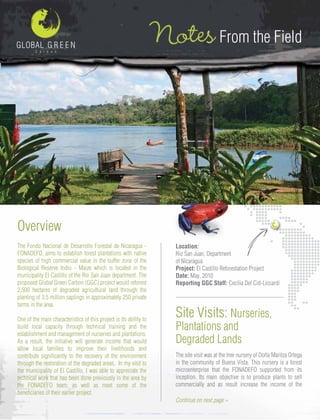
Notes from the field
- 1. Location: Rio San Juan, Department of Nicaragua Project: El Castillo Reforestation Project Date: May, 2010 Reporting GGC Staff: Cecilia Del Cid-Liccardi The Fondo Nacional de Desarrollo Forestal de Nicaragua - FONADEFO, aims to establish forest plantations with native species of high commercial value in the buffer zone of the Biological Reserve Indio - Maize which is located in the municipality El Castillo of the Río San Juan department. The proposed Global Green Carbon (GGC) project would reforest 2,500 hectares of degraded agricultural land through the planting of 3.5 million saplings in approximately 250 private farms in the area. One of the main characteristics of this project is its ability to build local capacity through technical training and the establishment and management of nurseries and plantations. As a result, the initiative will generate income that would allow local families to improve their livelihoods and contribute significantly to the recovery of the environment through the restoration of the degraded areas. In my visit to the municipality of El Castillo, I was able to appreciate the technical work that has been done previously in the area by the FONADEFO team; as well as meet some of the beneficiaries of their earlier project. Overview From the FieldNotes The site visit was at the tree nursery of Doña Maritza Ortega in the community of Buena Vista. This nursery is a forest microenterprise that the FONADEFO supported from its inception. Its main objective is to produce plants to sell commercially and as result increase the income of the Site Visits: Nurseries, Plantations and Degraded Lands Continue on next page »
- 2. family. The nursery produces about 20,000 plants annually and creates temporary jobs for women living close to the property of Doña Maritza. The species produced are mahogany (Swietenia macrophylla), Roble Macuelizo (Tabebuia rosea), Cortez (Tabebuia chrysantha), and Cedro macho (Carapa guianensis). The next stop in our field visit was the property of Florencio Demetrio Mendoza located in the Community of Laureano Mairena. Don Florencio showed us the forest plantation he established utilizing Mahogany (Swietenia macrophylla) and Cedro macho (Carapa guianensis) in a site originally covered with brush and low trees (known locally as tacotal bajo). Don Florencio explained the management regime he is following to maintain the quality of his trees and stressed that he would like to expand the current plantation to other areas in his property. He thinks of the trees as a savings account with a long-term return. He may not be able to enjoy the benefits, but he is making sure his grandchildren have better economic conditions and a better environment. The following visit was to the plantation of Doña Cristina Berroteran also in the community of Laureano Mairena. She represented the group of women farmers – one of FONADEFO’s target groups – who also have forest plantations. In her case, Doña Cristina established a nursery on her property to produce her own plants and in that way lower the cost of the seedlings of Macuelizo (Tabebuia rosea) and Cedro macho (Carapa guianensis). Her plantations were established in two hectares of open area/degraded grassland. Finally, we visited some of the sites that have been identified by the FONADEFO team to be possibly included in the next Global Green Carbon project. These areas were converted to agricultural lands and later on used as pastures. It is important to remember that these sites were originally areas of primary forest that as result of the advancement of the agricultural frontier have been reduced to forest fragments. From the FieldNotes
- 3. The GGC project, particu- larly its component to strengthen citizen partici- pation, aims to build up the role of women in their communities by promot- ing their contribution in the development of the communal structure and making them partners in defining communal priori- ties, needs, and invest- ments. It is recognized that the contribution of women has been traditionally low in terms of forestry activities. However, as these activities become prioritized and integrated into the family, the importance of female participation increases and can reach a level of equity with men. We see the primary opportunity in the development and cultivation of nurseries. The program promotes the participation of women in all areas of the rural farm, not only in traditional courtyard activities and in the management of small farm animals, but also in the agrofor- estry systems. Their involvement secures their participation in training sessions, exchanges and field practices. To make sure the activities take place, the plan includes the allocation of resources to establish measurable gender indicators that can be monitored periodically. Recommendation to strengthen the issue of gender equality: 1. Create a specific component to support women and help them overcome the socio-cultural and family barriers that prevent young girls and teenagers from taking advantage of the training opportunities and workshops offered within the context of the program. 2. The scholarship program has to gradually achieve a 50% female participation by its end. The scholarships for female recipients must include a sexual and reproductive health component. 3. Create the conditions for a substantive increase of women’s participation in the loan program. 4. The Association of Municipalities of Río San Juan (AMURS) should specifically promote women’s participa- tion in the strengthening of local organizations by establish- ing measurable gender indicators that can be monitored periodically. A Spotlight on Gender Equality Cecilia Del Cid-Liccardi, has conducted research evaluating the impact of agroforestry systems on small farm revenue and natural resource conservation in the Peruvian Amazon. She also has significant experience working on community development initiatives in Guatemala. Her focus at Yale School of Forestry was on tropical forest management and restoration. She is a native Spanish speaker, fluent in English and Portuguese. She holds a B.A. in Biological Sciences from Smith College and a Master of Forestry from Yale School of Forestry & Environmental Studies. Staff Profile: www.globalgreencarbon.com From the FieldNotes